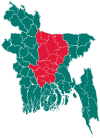Munshiganj Sadar Upazila
| Munshiganj Sadar মুন্সিগঞ্জ সদর | |
|---|---|
| Upazila | |
 Munshiganj Sadar Location in Bangladesh | |
| Coordinates: 23°27.5′N 90°32.5′E / 23.4583°N 90.5417°ECoordinates: 23°27.5′N 90°32.5′E / 23.4583°N 90.5417°E | |
| Country |
|
| Division | Dhaka Division |
| District | Munshiganj District |
| Area | |
| • Total | 160.79 km2 (62.08 sq mi) |
| Population (1991) | |
| • Total | 294,823 |
| • Density | 1,800/km2 (4,700/sq mi) |
| Time zone | BST (UTC+6) |
| Website | Sadar.gif Official Map of Munshiganj Sadar |
Munshiganj Sadar (Bengali: মুন্সিগঞ্জ সদর) is an Upazila of Munshiganj District[1] in the Division of Dhaka, Bangladesh.
History
During the Mughal rule the present Munshigonj town including the outlying areas was known as Idrakpur which was named after the then Mughal faujdar Idrak. A village on the outskirts of Munshigonj town is still known as Idrakpur. During the British rule Idrakpur was renamed as Munshigonj after the name of Munshi Enayet Ali, the local zamindar and the inhabitant of the village Kazi Kasba in Rampal.
In 1971
When the Pakistan Army began mass-killing and massacre in Dhaka city on the night of 25 March the students and youths of Munshiganj raided the armoury and captured arms and ammunitions to resist the Pakistan Army on 29 March.[2] They successfully guarded the river-side area to check the onrush of the Pakistan army towards Munshigonj . The people of Narayanganj in alliance with the youths of Munshiganj resisted an attack of the Pakistan Army on 31 March. The Pak army first penetrated into Munshigonj on 9 May and killed some youths at Kewar on 14 May.[2] The house of Radhika Mohan Ghosh at village Nayagaon on the bank of the Dhaleshwari had been the secret shelter and outpost of the freedom fighters. Attacks on the ferries of the Pakistan Army on the river were launched from the roof of this pucca building.
Geography
Munshiganj Sadar is located at 23°27′30″N 90°32′30″E / 23.4583°N 90.5417°E . It has 50609 households and total area 160.79 km².Munshiganj (Town) consists of 9 wards and 42 mahallas.The area of the town is 14.17 km2. The population of the town is 52071; male 51.62% and female 48.38%; density of population is 3674 per km2. Literacy rate among the town people is 49.3%. The town has two dakbungalows. The old high school name is Munshigonj Multiletaral High school, but nowadays the famous high school is K.K. Govt. Institution. Other famous high school is A. V. G. M. Govt. girls high school.
Demographics
As of the 1991 Bangladesh census, Munshiganj district, formerly a subdivision under Dhaka district, was established in 1984. It consists of 6 upazilas, 67 union parishads, 662 mouzas, 906 villages, 18 wards, 73 mahallas and 2 municipalities. The upazilas are gazaria, tongibari, serajdikhan, lohajang, sreenagar and munshiganj sadar. Munshiganj is one of famous district in Bangladesh and it has great reputation.[3]
Administration
Munshiganj Sadar has 12 Unions/Wards, 129 Mauzas/Mahallas, and 219 villages. There has a hospita named Munshigonj Sadar Hospital of 200 beds. There is a very famous and historic college named Haragonga College Munshiganj is also called as Bikrampur.
Points of interest
Idrakpur Fort (1660) at Munshigonj town, Panditer Bhita (birthplace of Atis Dipankar ) at Vajrayogini, Baba Adam’s Mosque at Rampal, home stead of Raja Vallala Sena, Rampal Dighi, Raja Harish Chandra’s Dighi, Kodal Dhoar Dighi, home stead of Raja Sreenath, marble statue of Ashutosh Ganguly at the library room of Haraganga College.
Education
Average literacy 35.5%; male 40.9%, female 30%. Educational institutions: college 4, high school 22, junior high school 4, primary teacher’s training institute 1, technical training centre 1, madrasa 9, government primary school 100, non-government primary school 9; noted old institutions: Government Haraganga College, Munshiganj High School.
See also
References
- ↑ Ratantanu Ghosh (2012), "Munshiganj Sadar Upazila", in Sirajul Islam and Ahmed A. Jamal, Banglapedia: National Encyclopedia of Bangladesh (Second ed.), Asiatic Society of Bangladesh
- 1 2 Ratantanu Ghosh (2012). "Munshiganj District". In Sirajul Islam; Ahmed A. Jamal. Banglapedia: National Encyclopedia of Bangladesh (Second ed.). Asiatic Society of Bangladesh.
- ↑ "Population Census Wing, BBS.". Archived from the original on 2005-03-27. Retrieved November 10, 2006.
